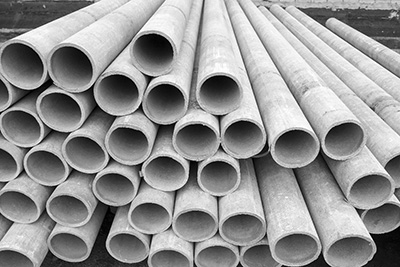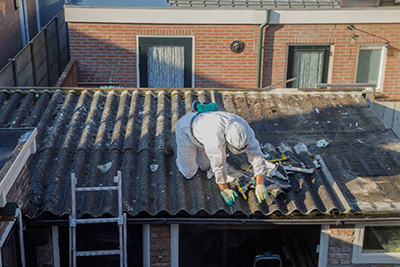Asbestos Cement & Concrete: A Complete Guide
Cement is one of the most essential construction materials, used in everything from foundations to roofing. Unfortunately, the use of asbestos cement until the 1980s potentially exposed many people to asbestos which can cause mesothelioma cancer and other diseases. But what is asbestos, exactly? And why was it used in cement and concrete products?
Use of Asbestos in Cement and Concrete
Asbestos is a naturally occurring mineral found in mountainous areas all over the world. It’s incredibly versatile, with long, thin fibers that can be spun into textiles, pressed into paper and felt products or crushed and mixed into a variety of materials. It was widely used in the construction industry. Homes today may still contain asbestos drywall, flooring, roofing and more. But another common use was in asbestos concrete and cement.
What Is Asbestos Cement?
Asbestos cement is any cement that’s made with asbestos added to the typical cement mixture, which is made up of aluminum, calcium, iron, silicon and other ingredients that can be found in natural materials, like clay, limestone and sand. It usually contains up to one-third white asbestos, also known as chrysotile, but the amount and type of asbestos depends on the product.
Cement is a powder that acts as a binding agent, meaning it helps other materials stick together. Asbestos concrete is one of the products that’s made with cement. To make concrete, asbestos cement is mixed with water and raw materials like gravel, sand or stone. The concrete is then poured into moldings to create a variety of shapes for many different purposes. Because cement is a part of concrete, in this article we’ll use these two terms interchangeably.
History of Asbestos in Cement and Concrete
The construction industry used asbestos cement extensively throughout the U.S. from the early 1900s through the mid-1980s. Usage peaked in the 1960s and early 1970s, then began to fall as the public and the Environmental Protection Agency (EPA) became aware of its dangers. In the 1970s, the EPA successfully banned several construction products that contain asbestos, including spray-on products and certain types of insulation.
Despite several attempts, there is still no complete asbestos ban in the U.S., but thanks to growing consumer awareness and strict regulations, U.S. companies no longer produce asbestos cement and concrete. However, due to a perceived low risk to the public, it is still legal to manufacture, import and use concrete products containing less than 1 percent asbestos.
Benefits of Using Asbestos Cement
Even after they knew about its links to dangerous diseases like mesothelioma, asbestos companies continued to use it in construction materials. Why?
Whether it’s added to cement, woven into ropes and blankets, or mixed into floor tiles, asbestos makes products resistant to moisture, heat and fire. It also makes them stronger without adding unnecessary weight. Using asbestos in cement had benefits, including:
- Easy blending with other ingredients
- Less cracking and breakage
- Higher resistance to water
- Decreased surface friction
- Corrosion resistance
- Increased structural integrity
Asbestos cement was also easy to get and affordable, providing a cheap and easy way for companies to make their products more durable.
Where You Might Find Asbestos Cement
Asbestos cement was used to create concrete products that were used in residential, commercial and industrial buildings all over the U.S. It’s also important to know that asbestos has similar properties to the other ingredients in concrete. In its hardened, final form, it’s nearly impossible to tell if there is asbestos in concrete by sight alone.
If they were built before the mid-1980s, it’s safest to assume that the following products may contain asbestos. Only professional testing can confirm the presence of asbestos in concrete.
Asbestos Cement Pipes

Water and sewage drainage pipes were often made of a material known as transite, which contained asbestos cement. Adding asbestos made the pipes stronger and resistant to chemicals and extreme temperature changes. It did all this while allowing the pipes to remain lightweight and creating a smooth, sealed surface that water could easily flow over.
Asbestos Cement Sheets

Asbestos cement sheets and boards contained a mixture of asbestos fiber, cement and silica. These sheets were fire-resistant and lightweight, yet durable, making them easier to work with than typical concrete. They were used in siding, roofing and ceiling tiles, and even as lining in industrial ovens. Today, they’re made with cellulose, but any sheets or boards produced before 1980 may still contain asbestos.
Other Materials With Asbestos Cement
Cement is used in a number of products to help with binding and sealing, and before 1980, many of these contained asbestos, including:
- Acoustic insulation
- Asbestos concrete used for building foundations
- Chimneys
- Flooring
- Flues in HVAC systems
- Gutters and downspouts
- Heat shields for electrical components
- Mortar used in masonry
- Pipes and drainage components
- Roofing
Health Risks of Asbestos Cement
The health risks of asbestos concrete and other cement products happen when the material is disturbed or damaged and releases dust into the air. That dust contains small fibers that can be hazardous to the lungs. When inhaled, they can become embedded in the lung tissue and potentially travel to other parts of the body.
Over a period of decades, inflammation and scar tissue can build up around the fibers, damaging the cells and causing asbestos-related diseases like mesothelioma, lung cancer, laryngeal cancer and asbestosis. Thousands of people in the U.S. are diagnosed with these illnesses each year, and many don’t know that they could be entitled to compensation.
Who’s At Risk for Exposure?
Set, hardened and undisturbed asbestos cement has a low health risk because the fibers are sealed within the concrete. But any activity that disturbs the cement, like demolition, drilling, pressure washing and sanding, can release asbestos fibers into the air.
In addition, although asbestos made concrete and other products more durable, they do eventually break down. With about a 70-year lifespan, many asbestos cement products are beginning to deteriorate. Anyone exposed to eroding or crumbling cement that was installed before the mid-1980s could be at risk.
Occupations Most At-Risk from Asbestos Cement
Before 1980, workers responsible for making the asbestos cement powder, which was then mixed into other products, were at a high risk for exposure. Those who mixed and poured asbestos concrete were also at risk. Mesothelioma can develop decades after exposure, so even today those who worked with asbestos products before its hazards were known continue to make successful mesothelioma claims.
The Occupational Safety and Health Administration (OSHA) put workplace regulations in place beginning in 1980. Today, the main risks are to those who demolish, replace or renovate asbestos cement products. Because there is no safe amount of asbestos to inhale, and some companies don’t strictly follow the rules, workers continue to be exposed. The most at-risk occupations are:
- Boilermakers
- Bricklayers
- Carpenters
- Cement factory workers
- Construction workers
- Demolition workers
- Flooring installers
- Foundation installers
- Masons
- Military veterans
- Pipefitters
- Plumbers
- Renovation contractors
- Roofers
- Shipyard workers
- Siding installers
Know Your Legal Rights
If you’ve been diagnosed with mesothelioma, you could be entitled to compensation for medical bills and pain and suffering. An experienced law firm like Early, Lucarelli, Sweeney and Meisenkothen can help you prove the connection between your asbestos exposure and mesothelioma diagnosis and hold the responsible companies accountable.
Over the past four decades ELSM has secured nearly $5 billion in mesothelioma compensation, with an average settlement of $1 to $1.4 million for mesothelioma victims. Contact us today to speak with a caring advocate and find out if you’re eligible for compensation.
FAQs
What are the health risks associated with asbestos cement?
When asbestos cement is damaged or disturbed, for example by breaking, drilling or pressure-washing, it can release hazardous fibers into the air. Inhaling these fibers can lead to diseases like mesothelioma, lung cancer and asbestosis, which often don’t develop until decades later.
Where can asbestos cement be found in buildings?
Asbestos cement can be found in the foundations, siding, ceilings and roofing of residential, commercial and industrial buildings. It was often formed into sheets and boards that served a variety of purposes and were widely used in construction.
Is asbestos cement still used today?
Due to strict regulation, U.S. companies no longer produce asbestos cement. However, it is still legal to import and build with cement and concrete that contains less than 1 percent asbestos, meaning there could be small amounts in these products today.
Request a Free Case Evaluation
Request a free case evaluation now if you or someone you love has been diagnosed with mesothelioma. The evaluation will cost you nothing. Our lawyers will travel to visit you at your convenience or conference call with you over the phone. We understand how difficult a time this is for you and will assist in any way that we can. You can also call us toll-free at 1-800-336-0086 at any time.

Results
The jury awards and settlements we have received for our clients are among the highest in the country.
Occupation/Exposure
Mechanic
Age
66
State
WA
Results
~$102,200,000
Occupation/Exposure
Cosmetic Talc User
Age
75
State
AZ
Results
~$22,200,000
Occupation/Exposure
Talc Powder User
Age
59
State
UT
Results
~$20,000,000
Occupation/Exposure
Home Renovator
Age
75
State
RI
Results
~$15,100,000
Occupation/Exposure
Electrician
Age
62
State
NV
Results
~$13,800,000
Occupation/Exposure
Plumber
Age
49
State
CA
Results
~$13,500,000
Occupation/Exposure
Abatement Worker
Age
70
State
CT
Results
~$12,600,000
Occupation/Exposure
Pipefitter
Age
58
State
OH
Results
~$12,200,000
Occupation/Exposure
Pipefitter
Age
65
State
NV
Results
~$12,000,000
Occupation/Exposure
Navy Veteran
Age
48
State
CA
Results
~$11,700,000
Occupation/Exposure
Air Force Veteran
Age
84
State
KY
Results
~$11,700,000
Occupation/Exposure
Hairdresser
Age
66
State
MD
Results
~$11,500,000
